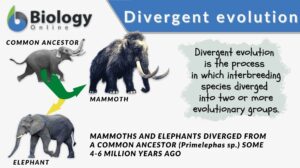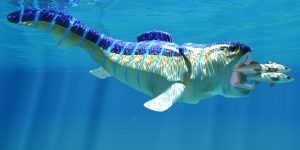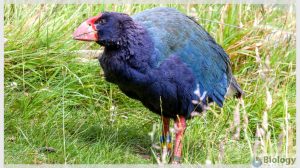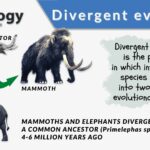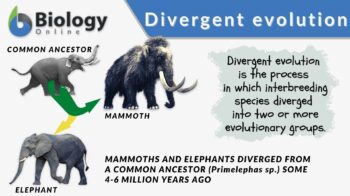
Divergent evolution
n., [daɪˈvɜːdʒənt ˌɛvəˈluʃ(ə)n]
Definition: Evolution wherein a common ancestral group diverged into two or more evolutionary groups
Table of Contents
Divergent Evolution Definition
Divergent evolution refers to the process by which interbreeding species diverged into two or more evolutionary groups. It means that these groups of species used to be similar and related. However, they became more and more dissimilar through time. Divergent evolution may also pertain to the process of tracing back two or more species to their common ancestor and knowing how these species have diversified or diverged. Divergent evolution is one of the three types of evolutionary patterns; the other two are convergent and parallel. The evolution of species is largely influenced by environmental factors and predation activities. Galapagos finches diverging from their descendant species is one of the most commonly cited examples of divergent evolution.
Etymology:
Divergent ecolution presumably was coined by an American missionary and naturalist, John Thomas Gulick. The term divergent came from Latin divergentem, from divergere, meaning “go in different directions”. Evolution, in turn, came from Latin evolutionem, from evolvere, meaning “to unroll”.
Synonyms:
divergence; divergent selection
Find out how divergence leads to allopatric speciation and not sympatric speciation. Join us and participate in our Forum discussion: Sympatric vs allopatric speciation
Divergent Evolution vs. Convergent Evolution
The type of evolution where species gradually become increasingly different from their ancestors is called divergent evolution. It differs from convergent evolution in the way that unrelated groups of species evolve analogous structures in spite of their evolutionary ancestors being very distant or unrelated.
Analogous structures refer to biological structures with comparable functions and yet they differ in regard to the developmental origin and anatomical features. In divergent evolution, species from a common ancestral origin evolve similar anatomical parts (called homologous structures) but with dissimilar functions.
One possible cause of divergent evolution is migration. When species migrates to a new habitat, it is confronted with new environmental conditions, and, therefore, it tends to evolve novel traits that make it better adapted to its new habitat. The evolution of the so-called Darwin finches is an example.
In convergent evolution, the chief driving force is environmental pressure. Species, although unrelated, tend to evolve traits that make them suited to their respective habitats. An example is the wings of insects, birds, and bats. For more on the differences and similarities between convergent and divergent, see the table below.
Comparison Between Divergent Evolution and Convergent Evolution | |
|---|---|
| Divergent evolution | Convergent evolution |
| An evolutionary pattern | An evolutionary pattern |
| Species gradually become different from their ancestors | Unrelated species evolve similar structures |
| Evolution resulted in multiple different species, leading to speciation | Evolution resulted in unrelated species with similar characteristics |
| Homologous structure development | Analogous structure development |
| Caused by environmental changes, migration | Caused by environmental changes |
| Another name for divergent evolution is divergent selection | Also called convergence |
| Example: Darwin’s finches | Example: wings of insects, birds, and bats |
Discover more examples of speciation associated with divergent evolution here: Sympatric vs allopatric speciation. Join us in our Forum now!
Divergent Evolution vs. Parallel Evolution
While species in divergent evolution essentially diverge and in convergent evolution merges, species in parallel evolution tend to evolve structures parallel to other species within the same environment. Similar to convergent evolution, the traits in parallel evolution evolved in species that are not evolutionary related.
The difference is that in parallel evolution the unrelated species evolved a similar mechanism to adapt to the same environmental conditions. In convergent evolution, unrelated species do not necessarily live in the same environment.
Parallel evolution differs from divergent evolution in fairly the same way as convergent evolution does. Both parallel and convergent evolution are associated with species from different evolutionary lineages. In divergent evolution, it is an evolution of a species that diverges from its ancestors.
Divergent Evolution vs. Adaptive Radiation
Adaptive radiation is defined as the process whereby several new species from a recent ancestral source diversify. Each of these species is adapted to utilize or occupy a vacant adaptive zone. This zone, thus, serves as an ecological opportunity for certain groups of organisms to diversify into different forms, often, in a rapid process.
Similar to divergent evolution, adaptive radiation leads to speciation and is likewise exemplified by Darwin’s Galapagos finches. However, the two concepts differ in the way that adaptive radiation deals more with small-scale evolution over a shorter span of time whereas divergent evolution looks through the evolution of species diverging from their ancestors over a relatively long span of time. Nevertheless, adaptive radiation may lead to divergent evolution over time as the species become more and more distinct from its ancestors.
Cause of Speciation
Divergent evolution occurs when a subgroup of a species evolves traits different from its ancestors. The trait usually sprung from selective pressures. Such pressures drive natural selection and compel organisms to evolve. Selective pressures may be biotic or abiotic. Biotic pressures are living factors in the environment, e.g. predation and competition. Abiotic pressures include non-living environmental factors, such as light, soil, and wind.
Learn more about speciation. Know the difference: Sympatric vs allopatric speciation. Join our Forum and let’s discuss!
Importance
In divergent evolution, homologous structures are structures indicating a species is diverging from its ancestor. These structures need not have the same function as those of the species’ ancestors. For example, the forelimbs of humans and bats are homologous structures. Although they are used differently, the basic skeletal structure is the same and they are derived from the same embryonic origin. Their similarity in this regard could indicate plausible evolution from a common ancestor.
This shows that divergent evolution allows species with common ancestral origin to be able to adapt to their own habitats. Thus, it is likely to ease competition among them since they evolve traits that make them explicitly suited to their habitat and ecological niche.
Divergent evolution also helps in promoting biodiversity. Since it leads to speciation, it could lead to a wide range of different organisms thriving in diverse habitats.
Examples
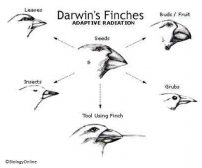
A prototype example of divergent evolution is Galapagos finches. Charles Darwin’s Beagle voyage led him to conclude that the finches diverged from their descendant species. While the birds share common features with their ancestors, they eventually developed structures that made them morphologically different from their descendants. For instance, they developed beaks that differ in shape and size to make them better adapted to their diet.
The more structural differences there are the greater the breadth of species divergence. Other examples of divergent evolution are as follows:
- A flock of births migrating and settling on a new island. Over time, this group becomes more adapted by developing new characteristics to enable them to survive in their new habitat. Thus, they become a different species from their ancestors and what was once one species has diverged into two.
- The diversity of the orchids where orchid species evolved differing traits (e.g. floral types)
- Peccaries (Tayasuidae) that diverged from the true pigs (Suidae) about 40 million years ago
- The evolution of humans and apes from a common primate ancestor
Watch this vid on divergent evolution:
Answer the quiz below to check what you have learned so far about divergent evolution.
Further Reading
References
- BIOdotEDU. (2019). Retrieved from Cuny.edu website: http://www.brooklyn.cuny.edu/bc/ahp/LAD/C3/C3_elecEnergy.html
- Evidence Supporting Biological Evolution. (1999). Science and Creationism: A View from the National Academy of Sciences, Second Edition. Retrieved from https://www.nap.edu/read/6024/chapter/4#14
- National Academy of Sciences and Steering Committee on Science and Creationism. Darwin’s Evidence for Evolution. (2019). Retrieved from Nyu.edu website: http://www.nyu.edu/projects/fitch/courses/evolution/html/evidence.html
© Biology Online. Content provided and moderated by Biology Online Editors

